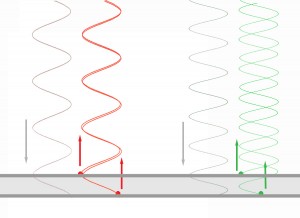After all the discussion of orange-throated and red-throated hummingbirds, I thought it would be helpful to add a brief and simplified summary of how the brilliant iridescent colors of hummingbirds are produced. These are structural colors, not pigment, which means they are reflected by microscopic structural features of the feather surface.

The diagram here shows how this happens. The surface of the feather is composed of layers of tiny air bubbles. When light strikes the surface of the feather, some light is reflected from the outer surface, and some light travels through the air bubble and reflects off the inner surface. Light (red in this example at right) with wavelengths that match the thickness of the air bubble are “amplified” as the reflected waves from the inner surface match up and combine with the reflected waves from the outer surface. Other wavelengths (such as the shorter green waves shown in this example) are “out of sync” when they combine after reflecting off both surfaces, and they cancel out. This is the fundamental process that creates the very pure and brilliant colors we see on hummingbirds.
This is an idealized example. In reality the structures that produce iridescent colors in hummingbirds are much more complex, with multiple layers of air bubbles. The refractive index of the material the light must pass through, along with many other factors, can alter the color that is produced, but it is the combined reflections from inner and outer surfaces of the air bubbles that creates iridescent colors. The entire system must be incredibly precise and uniform. The difference between red and orange could be a difference of a few nanometers, and one of the most amazing things about this is that there is so little observed variation in hummingbird colors.
When Ruby-throated Hummingbirds develop orange throats, that means a tiny shift to reflecting slightly shorter wavelengths of light. This could be the result of a thinner layer of air in each bubble, or a thinner layer of solid material forming the outer surface, or a slightly lower refractive index of that material, or many other possible variables.
Still lots of questions…


Wow…is there evidence of male colour shifts (e.g. red to orange) when in mating dance flights?
I’m in Arizona and a couple of days ago we had a hummingbird that had not only a gold throat, but also the whole head. We had one a month or so ago that had a pale blue head and back. What was it?
Hi Gayla, My first guess would be a male Anna’s Hummingbird. They have iridescent color over the entire head, and at certain angles it can flash golden-yellow-green. A less likely possibility is some kind of hybrid
I have traveled a lot in the united states and I have watched these magnificent colored humming birds are all in different colors in each state I have ben in, but I do think the sunlight plays a big part in what colores stand out the most.
I love the iriedscence of the humming birds, I noticed the males are more colorful also.
Pingback: It's The Color Changing Season. And This Time, It’s A Bird!
Pingback: Meet The Bird That’s Been Changing Colours Before It Became So Mainstream - OddPad.com
Pingback: The Strange Anatomy of Hummingbirds - Best Skills
Pingback: The Strange Anatomy of Hummingbirds - Skeptic.live | Skeptic.live
Pingback: Phoenix area hummingbirds – Myr's Bytes
Pingback: Come fingere di essere colorati – amorefisico
Nice & informative article on iridescence, thanks for sharing knowledge!
Pingback: The Strange Anatomy of Hummingbirds - SciShow | ReflectVideo
Pingback: Bay Nature: Find Some Green in Nature for St. Patrick's Day
Pingback: TIL A hummingbird’s brilliant throat color is not caused by feather pigmentation, but rather by iridescence in the arrangement of the feathers. Light level, moisture, angle of viewing, wear and tear and other factors all influence just how bright and colorful the throat may appear. – BradAd
Pingback: The ruby throated hummingbird – everyjonahhasawhale.com
I am in the town of Day in upstate New York. On August 10th, I had just filled my feeder and was standing inside the screened porch very very near the feeder. Three hummers suddenly hovered at the feeder probably because they saw me. I have not normally seen three come together.without chasing each other. The bird in the middle had an iridescent throat of gold.
Really beautiful in the sunlight! Never ever saw one like that before. I wondered what
I saw. How I wish I had been able to take a picture! Can you tell me what I saw?
Many thanks!
I live in the southwestern most corner of North Carolina. I have two humming birds coming to my feeder, both very territorial, who have buff throats and chests, but if the turn a certain way or light in the bush nearby and sit at a certain angle, they have beautiful golden yelliw chests and throats. I thought they were just female ruby throats, but now I’m not sure. They have kind of olive green backs.
Pingback: Hummingbirds and peacocks are lying to us – Science is Really Weird
I enjoyed the article immensely, as I have bean watching these little birds curiousIy for a long time and noticed there beautiful iridescent colors.
In fact I watch them so much that a friend gave me a hummimg bird feeder for Christmas so I could watch them from my own front window.
3/19/24 3rd season my orange throat has shone up I’m in sumrall ms. He was very young the 1rst season he arrived, he’s taking over the Feeder as he has done in the past , he’s actually running birds out of the tree that he hangs out in which is overlooking the fear he’s fun to watch and I’m sure he’ll hang around all year just like he’s done in the past, stevehaightconst@ Gmail.com